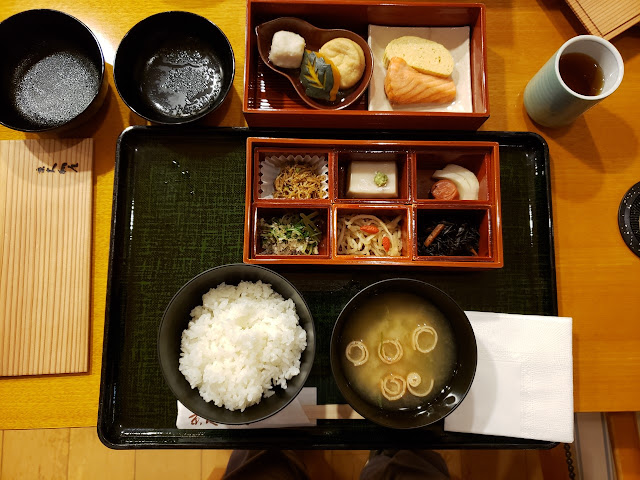Today's our last day of sightseeing. Tomorrow we catch a domestic JAL flight from Osaka to Tokyo then board our JAL international flight to Seattle.
We had breakfast this morning in the Japanese restaurant in the hotel. It was a set menu with (bottom to top) rice, miso soup, several small veggie dishes, tofu and pickle dishes, salmon, a slice of egg roll, tofu, squash (carved in the shape of a leaf) and green tea. It looks a little skimpy but it was just right to start off the day.
We caught a train to Nara to visit Todaiji temple, the deer park and Kasuga Shrine. Ikuko found that feeding the deer the "deer crackers" was risky. They bow to ask for a piece of cracker but if you don't feed fast enough they begin to nip your clothes and tug. Sometimes they get too close and nip a little skin. It reminded me of when we were in Venus and she wanted to feed the pigeons. She soon looked like a Christmas tree with pigeons clinging to her hair and clothes begging something to eat.
This old boy was surveying the action, I think he was keeping an eye on the young bucks to make sure they didn't mess with his harem.
The entrance to Todaiji Temple was awash with people. This is the time of year when students make field trips so no matter which temple or shrine you visit, in addition to the other tourists, there are plenty of students. I envied their youthful energy and enthusiasm.
The Todaiji (Lit. Eastern Great Temple) is one of the world's largest wooden buildings.
Todaiji is famous for the large (15 meters) statue of Buddha cast in bronze and originally covered with gold leaf. This photo also shows the Bodhisattva on the Buddha's right.
These schoolboys were wriggling through a special hole cut through one of the columns. This one was proud to have made it through. The hole was made to be the same size as the Buddha's nostril. The idea being that if you can squeeze through the hole you are assured of a better life
Kasuga Shrine claims fame for its lanterns and the Japanese Cedar seen below on the left. The cedar is more than one thousand years old. It has been damaged by lightning and is tied together around the top.

The entrance to Fukushimi Shrine is through one of its torii gates. This one is the largest of the thousands we saw.
This shrine is also famous for its dog gods. The two statues with the red neckerchiefs are representative of the many we saw throughout the grounds.
Fushimi Inari Shrine is known for its torii gates.















No comments:
Post a Comment